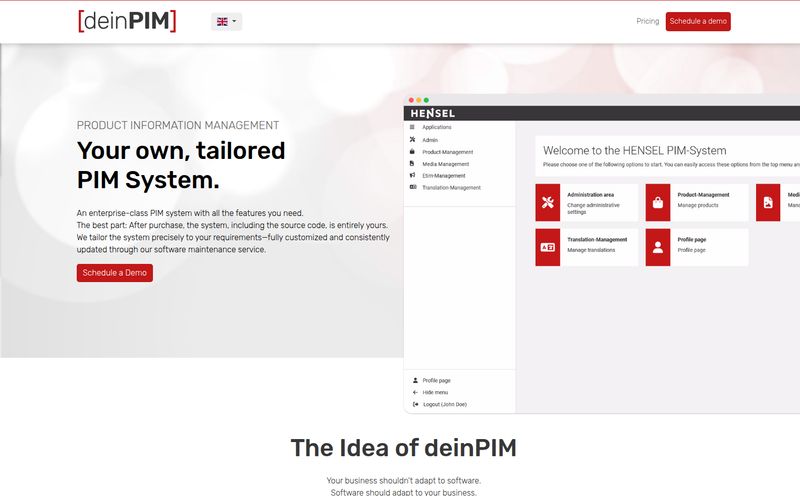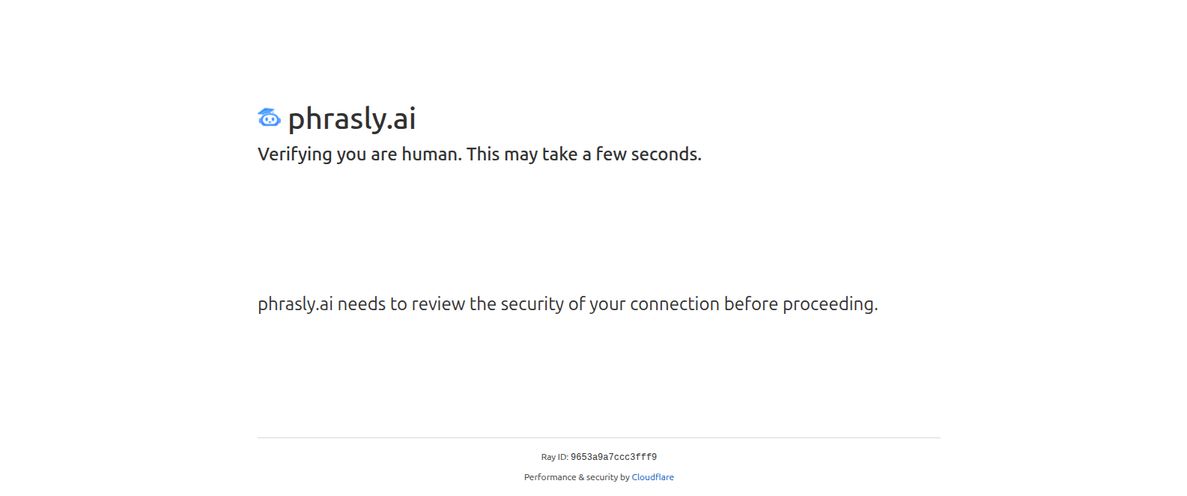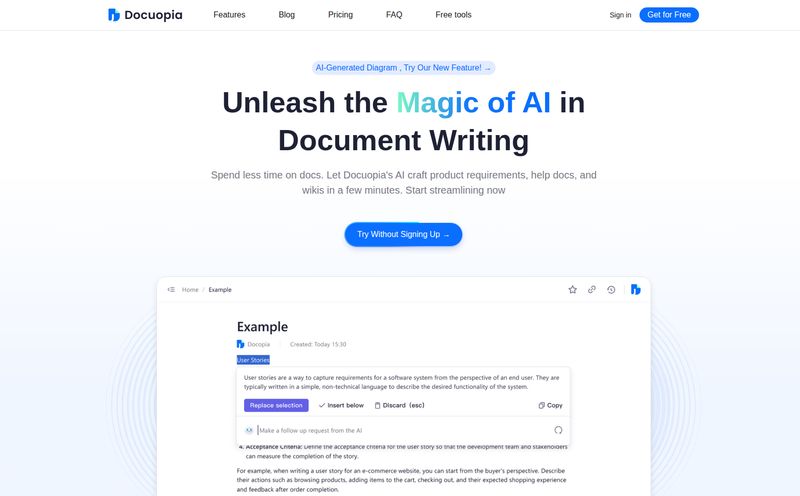The content treadmill is exhausting. As an SEO, I feel like I'm in a constant race against, well, everyone. We have to create high-quality content, optimize it perfectly, track its performance, and then do it all over again tomorrow. It’s a grind. So whenever a new tool pops up promising to make that grind a little less… grindy, my ears perk up. But my skepticism meter also goes into overdrive.
The latest tool to cross my desk is Buzzwriter.ai. The name is catchy, I'll give it that. Its homepage makes some bold claims about being for “SEO specialists in AI content writing and boosting website ranking.” Okay, you have my attention. But I’ve seen a hundred tools that promise to be the silver bullet for SEO. Most of them are just shiny GPT-wrappers with a fancy UI.
So, is Buzzwriter any different? I decided to pop the hood, kick the tires, and see if it’s all buzz and no substance. Here’s what I found.
So What Exactly Is Buzzwriter?
At its core, Buzzwriter is a suite of AI-powered tools designed to streamline the entire content lifecycle. Think of it as a multi-tool for the modern content marketer or SEO. It isn’t just an AI writer. It tries to connect the dots between content creation, search engine optimization, and actual traffic analysis. The goal is to stop you from having to juggle ten different tabs for your keyword research, writing, editing, and performance tracking.
It combines an AI article writer with an SEO traffic analyzer and a few other interesting bells and whistles. The whole idea is to create a more cohesive workflow. Instead of writing a post in one tool and then checking its rankings in another, Buzzwriter wants to bring it all under one roof. A noble goal, for sure.
A Look at the Core Features
I spent some time poking around the dashboard, and a few things immediately stood out. It’s not just about churning out words; there’s a clear strategic element baked in.
The AI Article Writer
This is the main event, right? The AI writer is designed to create SEO-focused articles. One feature I found particularly neat is the ability to extract a content outline from any URL. This is a huge time-saver for competitive analysis. You can see how a top-ranking article is structured and use that as a scaffold for your own, better version. It also has options for tone of voice and point of view, which are becoming standard but are still crucial for creating content that doesn't sound like a robot wrote it. It’s fast, and the quality is a decent starting point. It’s not a “one-click and publish” solution—and frankly, no AI writer is if you care about quality.
">
The SEO Traffic Analyzer
This was a pleasant surprise. Buzzwriter integrates with your Google Search Console to pull in data and provide insights. It visualizes your traffic, tracks rankings, and helps you understand user behavior. Is it going to replace a full-blown analytics platform like Semrush or Ahrefs? No, not at all. But for a content-focused tool, having this data right where you create your articles is incredibly convenient. It helps close the feedback loop: you write, you publish, and you see the impact without leaving the platform. That’s a smart workflow.
The Secret Sauce: Article Humanization
Okay, this is the feature that really grabbed my attention. In an age where Google's Helpful Content Update is the boogeyman in every SEO's closet, the term “humanization” is potent. Buzzwriter offers a specific function to take an AI-generated text and... well, make it sound more human. What does that mean in practice? It seems to be about refining sentence structures, improving flow, and injecting more natural language patterns. I think this is less about tricking Google and more about making the content genuinely better for the reader. AI can be repetitive and a bit soulless. A tool that actively tries to fix that is on the right track in my book.
Let’s Talk Money: Buzzwriter Pricing and Plans
Alright, let's get down to the brass tacks. A tool can have all the features in the world, but if the price is wrong, it’s a non-starter. Buzzwriter has a pretty flexible pricing structure, including—and this is great—a free plan.
| Plan | Monthly Price | Who It's For | Key Features |
|---|---|---|---|
| Forever Free | $0 | Curious beginners or those on a tight budget. | 3 AI articles/month (500 words), 50 Buzzcoins. |
| Basic | $29 | Solo bloggers, freelancers, small businesses. | 12 AI articles/month (800 words), GSC integration, Indexing help, Humanize 2 articles. |
| Pro | $79 | Small agencies, serious content marketers. | 30 AI articles/month (1000 words), 5 GSC properties, Internal linking, SEO score, Tone & POV options. |
| Enterprise | $199 | Large agencies, in-house marketing teams. | Unlimited everything, APIs, priority support. |
Note: They offer a significant discount (around 20%) for annual plans, which is pretty standard practice.
What's This About 'Buzzcoins'?
Buzzwriter uses a credit system called Buzzcoins, which you get with each plan or can buy as an add-on. These seem to be the currency for premium actions, primarily the Article Humanization feature. It’s an interesting model. It allows them to offer a lower base price and lets users pay for the more resource-intensive features as they need them. I don't love credit systems, but this one seems straightforward enough.
">
The Good, The Not-So-Good, and My Takeaway
No tool is perfect. After my test drive, here’s my balanced take. The biggest advantage is the efficiency. Having your writer, optimizer, and analyzer in one place is a genuine time-saver. The content quality is high for an AI tool, and the focus on SEO strategy—like the URL outline extractor and GSC integration—is a huge plus. It’s also surprisingly affordable, especially the Basic plan.
On the flip side, like any tool of this nature, its effectiveness hinges on the user. You can’t just blindly accept the AI's output. You need to be the human in the loop, the editor who refines and adds that final spark of insight. That’s not really a knock on Buzzwriter specifically, but the reality of using AI in 2024. Also, some of the really powerful features, like advanced tone options and internal linking suggestions, are locked behind the more expensive Pro plan. That’s to be expected, but something to be aware of.
So, Who Is Buzzwriter Built For?
After playing with it, I have a pretty clear idea of the ideal user. If you're a solo blogger or a freelance content creator, the Basic plan is an incredible value proposition. It automates the tedious parts of content creation, allowing you to focus on quality and promotion.
For small SEO agencies or marketing teams, the Pro plan looks like the sweet spot. The ability to manage multiple projects and GSC properties, plus the deeper SEO suggestions, can seriously streamline your client work. The Enterprise plan is clearly for the big dogs who need unlimited scale and API access.
It's probably not for the hardened SEO purist who lives and breathes in Ahrefs and builds their own Python scripts for data analysis. But for the 90% of us who just need to create great, optimized content efficiently, it hits a very compelling middle ground.
My Final Verdict on Buzzwriter
So, is Buzzwriter just another drop in the AI ocean? I’m leaning towards no. It's a thoughtful, well-designed platform that understands the actual workflow of a content creator. It’s not trying to replace you. It’s trying to be your co-pilot, handling the navigation and engine checks so you can focus on flying the plane.
The combination of content generation with tangible SEO analytics and that unique humanization feature makes it stand out. While it won't magically solve all your SEO woes—nothing will—it can definitely make the content part of the equation a whole lot faster and more data-driven. For the price, especially with the free plan to get your feet wet, it’s absolutely worth a look.
">
Frequently Asked Questions About Buzzwriter
- 1. What is Buzzwriter in simple terms?
- Buzzwriter is an all-in-one AI platform for content creators and SEOs. It helps you write SEO-friendly articles, analyze your website's traffic by connecting to Google Search Console, and even refine AI text to sound more human.
- 2. Is the AI content from Buzzwriter safe for SEO?
- This is the million-dollar question! Google's stance is that it rewards high-quality content, regardless of how it's produced. The key is to use Buzzwriter as a tool, not a crutch. Use it to generate a solid first draft, then edit, add your unique insights, and fact-check. The 'humanization' feature is also designed to help with this, making the text less robotic and more valuable to readers.
- 3. How does the 'Article Humanization' feature actually work?
- While the exact algorithm is proprietary, it likely involves advanced natural language processing (NLP) models. These models analyze the text for common AI patterns—like repetitive sentence structures, overly formal tone, and lack of varied vocabulary—and then rewrite those sections to improve readability and flow, mimicking a more natural human writing style.
- 4. Can I really use Buzzwriter for free?
- Yes! Buzzwriter offers a 'Forever Free' plan. It's limited, giving you 3 articles per month at 500 words each, but it's a fantastic way to test out the core AI writer and get a feel for the platform's interface without any financial commitment.
- 5. Does Buzzwriter replace tools like Ahrefs or Semrush?
- No, not completely. While Buzzwriter has its own SEO traffic analysis feature, it's more of a convenient, top-level dashboard. Tools like Ahrefs and Semrush offer much deeper analytics, backlink analysis, and extensive keyword research functionalities. Buzzwriter is best seen as a content creation and on-page SEO tool that complements these larger platforms.
- 6. What are Buzzcoins used for?
- Buzzcoins are a form of in-app credit. You receive a certain amount with your monthly plan and can purchase more. They are primarily used for premium features like running the Article Humanization tool or generating additional AI articles beyond your plan's limit.



